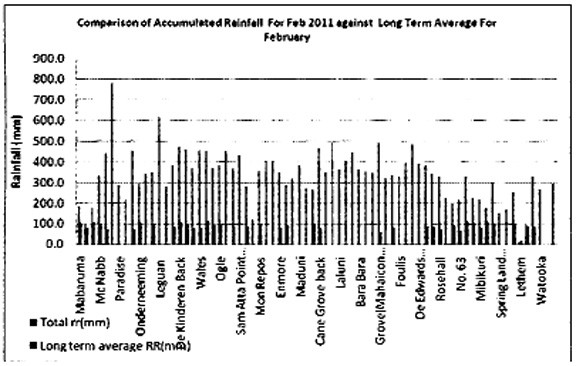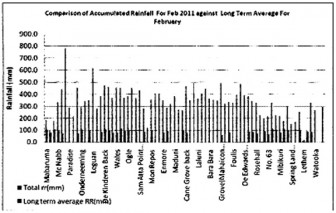Dear Editor,
The recent statements in the Stabroek News editorial dated Monday, February 28, entitled ‘Six years of marking time’ reflects biased reporting and is not unexpected of the Stabroek News as it continues its campaign to malign the government by providing misinformation to the public. The editorial deliberately neglected to highlight the challenges of climate change and the strides being made by the government to implement measures and necessary infrastructure to deal with the much larger and complex issue of climate change we are confronted with globally.
The rainfall experienced in February 2011 exceeded the long term average at many locations by at least 250 per cent above normal rainfall. Nevertheless, no more than 15 acres of rice was damaged and the inconvenience of residents and farmers was greatly minimized due to the investments made in the area of drainage and irrigation over the years to build new structures and reactivate/rehabilitate structures that were abandoned by the previous administration.
These include:-
● Construction of sluice at Golden Fleece
● Construction of sluice at Westbury
● Re-constructed pumping station at Cozier and Anna Regina
● Construction of sluice at 4 sluices at Moleson Creek which allows for cultivation of 12,000 acres of farmland
● Construction of sluice at De Willem
● Construction of sluice at Retrieve, Mahaicony to drain additional 12,500 acres of farmland
● Construction of sluice at Profit, Abary to drain 10,200 acres of farmland south of main canal
● Rehabilitation of drainage and irrigation structures in Black Bush Polder, Crabwood Creek, Vreed-en-Hoop, La Jalousie, Den Amstel-Fellowship, Vergenoegen/Bonasika, Canals Polder
● Implementation of Water Users Association
● Construction of new outlet for EDWC at Hope/Dochfour
● Maintenance of drainage and irrigation system with the procurement of 38 excavators
● Installation of high capacity drainage pump at Canal No 2
● Resuscitate Trafalagar drainage pumps
● Construction of 2-unit pumping station at Greenfield, ECD
As a result of a continuous maintenance programme implemented by the Ministry of Agriculture’s National Drainage and Irrigation Authority (NDIA), there was a rapid run-off of water from many vulnerable areas. There were several interventions that were facilitated by the NDIA to mitigate these conditions, including the deployment of personnel, equipment and the clearing of outfall channels in vulnerable areas. The NDIA’s Community Drainage and Irrigation Project (CDIP) also provided necessary support as they assisted in the clearing of garbage and debris from critical drainage canals. During this period there was strict monitoring of drainage infrastructure to ensure efficient operation. These works have even been commended by some critics such as the Kaieteur News which stated in its ‘Peeping Tom’ article of February 25, 2011 that “this time there was a rapid drain-off of waters in most areas, indicative of improved drainage” and “credit must be given to the authorities.”
Over the years, drainage and irrigation works undertaken have been commended by the World Bank in its Rapid Assessment Report on Flood Related Damage to Coastal Guyana in January 2009, which stated that significant progress has been made in improving the discharge capacity in populated areas. In addition, the report stated that this was accomplished largely through the implementation of a concerted maintenance and rehabilitation programme.
Stabroek News deliberately ignored the fact that larger acreages of agriculture lands are under cultivation and that there is a boom in housing development which has transformed Guyana’s landscape, thereby increasing the demand for drainage and irrigation. This has prompted the NDIA, other government agencies and local government bodies to increase the drainage capacity of Guyana’s coastland which is six feet below sea level – another important fact the Stabroek News editorial deliberately chose to neglect.
Prior to the recent rainfall, twelve drainage and irrigation projects were successfully completed in the Buxton-Friendship area which was part of the Minister of Agriculture’s commitment to improve drainage and irrigation in the area. These projects, totalling more than $115M, were part of the NDIA’s master plan to ensure communities and farmers are protected from the adverse effects of climate change by strengthening the drainage infrastructure. In expectation of the heavy rains, a key culvert was cleared by the NDIA to facilitate the opening of the Buxton sluice doors which resulted in a significant amount of water being drained from the land. Additionally, two pumps were installed to boost drainage in the area.
Since climate change has begun to affect countries like Guyana, the government has been investing heavily in infrastructure such as the EDWC to protect the livelihood of its people. This facility has not been neglected since significant sums of money spent by government over the years have ensured the efficient maintenance of this facility.
With regard to the East Demerara Water Conservancy (EDWC) northern relief channel at Hope-Dochfour, this facility which is part of the climate change adaptation strategy of the MOA’s NDIA when successfully completed will provide additional drainage for the EDWC, which is a unique flood structure for the East Coast of Demerara. Also, there will be reduced flooding in the Mahaica-Mahaicony areas. Works have already commenced on the much needed channel. It is important to note that relevant and necessary technical analysis was done by both local and international experts before commencement of the channel began.
With regard to the Conservancy Adaptation Project (CAP), in a letter dated October 29, 2010 in the Stabroek News, Mr Frederick Flatts, Senior Civil Engineer, Agricultural Sector Development Unit (ASDU) noted that some components of the project had been completed and commissioned in November 2009. The completed activities included the supply, delivery and installation of a long-reach excavator and a punt and pontoon. The rehabilitated Lama No1 and No2 sluices were also commissioned.
Protecting Guyana’s vulnerable coastlands from the worst impacts of climate change is no trouble-free task for any administration. As a developing country, Guyana faces massive adaptation costs against sea level rise and inland flooding. Higher than normal spring tides and flash flooding are perpetual realities we are threatened with. By pursuing a climate smart development approach, which is testimony to the government’s commitment to not only treat symptoms, but to tackle root cause and promote long-term solutions to climate change, economic development is promoted. The protection of forests, for example, is imperative for flood management. According to the McKinsey Report, estimates have shown that a 1% loss in forest cover will result in 0.4-2.8 per cent increase in the occurrence of a catastrophic flood. Other large-scale actions are mangrove restoration and agriculture diversification in a climate resilient economy. If Stabroek News is interested in being helpful it should recognize the challenges climate change presents to our country and support Climate Smart Development.
Rainfall in February 2011 exceeded the long term average at many locations by at least 250 per cent above normal rainfall.
Yours faithfully,
George Jervis
Permanent Secretary
Ministry of Agriculture







